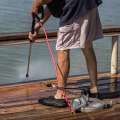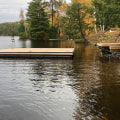In today's world, accessibility is a crucial factor in any design consideration. This is especially true in the world of boating, where having a dock that is accessible for all boating needs is essential. Whether you are a boat owner, a dock designer, or simply someone who enjoys spending time on the water, understanding how to make a dock accessible for all can greatly improve your boating experience. In this article, we will explore the key aspects of creating a floating dock design that prioritizes accessibility and caters to the needs of all boaters.
From design considerations to practical tips, we will cover everything you need to know to make your dock accessible for everyone. So, if you're ready to take your dock design to the next level and create an inclusive environment for all boaters, keep reading!To begin with, it's important to understand the different aspects of dock accessibility. This includes the construction, installation, maintenance, and repair of your dock. All of these elements play a crucial role in ensuring that your dock is safe and functional for your boating needs.
Let's take a closer look at each of these aspects and what you need to know.
Construction:
When building a dock, it's important to consider accessibility from the start. This means making sure that the dock is strong enough to support the weight of both people and boats. It's also important to consider any potential hazards such as slippery surfaces or sharp edges. Additionally, ramps or handrails may need to be installed for easier access.Installation:
Proper installation is key to ensuring that your dock is safe and secure.It's important to follow all manufacturer instructions and guidelines when installing your dock. This includes using the right tools and materials, as well as making sure that the dock is level and stable.
Maintenance:
Regular maintenance is essential for keeping your dock in good condition. This includes checking for any damages or wear and tear, as well as cleaning and treating the surface to prevent slipping. It's also important to regularly check any ramps or handrails for stability and repair as needed.Repair:
Even with proper maintenance, your dock may still need repairs from time to time.It's important to address any damages or issues as soon as possible to prevent further damage and ensure the safety of your dock. Now that you have a better understanding of the different aspects of dock accessibility, let's take a look at some design ideas and services for floating docks. Floating docks are a popular choice for their versatility and ease of use. They can be easily adjusted to accommodate different water levels and can even be removed during the off-season. If you're looking for design ideas, consider adding features such as built-in seating or storage to make your dock more functional and convenient. When it comes to services for floating docks, there are many options available.
From custom designs to installation and maintenance services, you can find professionals who specialize in floating docks to help bring your vision to life. Just be sure to do your research and choose a reputable company with experience in building and servicing floating docks. Lastly, let's talk about the cost and materials needed for building a dock. The cost of building a dock can vary depending on factors such as size, materials, and location. On average, homeowners can expect to spend anywhere from $2,000 to $50,000 on a dock.
As for materials, some popular options include wood, aluminum, and composite decking. It's important to choose materials that are durable and able to withstand harsh weather conditions. Overall, dock accessibility is crucial for any boat owner. By considering all aspects of construction, installation, maintenance, and repair, as well as exploring design ideas and services for floating docks, you can ensure that your dock is safe and functional for all your boating needs.
Cost and Materials: What to Expect
When it comes to building a dock, there are several factors to consider when it comes to cost and materials. These include the size of your dock, the materials used, and any additional features or amenities you may want to include. The size of your dock will greatly impact the overall cost.A larger dock will require more materials and labor, resulting in a higher cost. Additionally, the type of materials used can also greatly affect the cost. For example, using composite materials instead of wood may be more expensive but can also provide longer durability and require less maintenance over time. Other factors to consider include any additional features or amenities you may want to include in your dock design. This can range from boat lifts and ramps to lighting and seating areas.
These features can add to the overall cost of your dock, but can also greatly improve accessibility for all boating needs.
Safety First: Construction and Installation
Having a dock is essential for any boat owner, but ensuring that it is safe and accessible for all boating needs is crucial. When it comes to building or improving a dock, safety should always be the top priority. In this section, we will cover important considerations for constructing and installing a safe and accessible dock. To start, it is important to carefully plan the design of your dock.Consider the location, water depth, and potential hazards in the surrounding area. It is also recommended to consult with a professional or follow building codes to ensure the structural integrity of your dock. When it comes to installation, using high-quality materials and proper techniques is key. The dock should be securely anchored and able to withstand various weather conditions.
Additionally, features such as handrails, non-slip surfaces, and adequate lighting should be incorporated for added safety. Regular maintenance and inspections are also crucial for keeping your dock safe and accessible. Any damages or wear and tear should be addressed immediately to prevent accidents or injuries. By prioritizing safety during construction and installation, you can ensure that your dock is a safe and enjoyable place for all boating needs.
Design Ideas and Services for Floating Docks
Making your dock more versatile and convenient is crucial for ensuring accessibility for all boating needs.There are many design ideas and services available that can help you achieve this goal. One great way to improve the accessibility of your dock is by adding ramps or gangways. These can be designed to accommodate different types of boats, such as kayaks, canoes, and larger vessels. Additionally, ramps can be equipped with handrails for added safety. Another design idea is to incorporate adjustable dock sections.
This allows you to adjust the height of your dock based on the water level, making it easier for boats of all sizes to access. You can also consider adding amenities such as benches, ladders, and even fish cleaning stations to your dock. These features not only make the dock more convenient for boaters, but also add to the overall functionality and accessibility. In terms of services, there are companies that specialize in designing and building accessible floating docks. They can work with you to create a custom dock that meets your specific needs and budget.
These professionals have experience in incorporating accessibility features into dock designs, ensuring that your dock is safe and easy to use for everyone. By incorporating these design ideas and utilizing professional services, you can make your floating dock more versatile and convenient for all boating needs. This will not only improve the overall accessibility of your dock, but also enhance the boating experience for all who use it.
Maintenance: Keeping Your Dock in Top Condition
When it comes to maintaining a dock, regular upkeep is essential for keeping it in top condition and ensuring the safety of all who use it. This is especially important when it comes to dock accessibility, as any damages or neglect can hinder its functionality and make it difficult for boaters to use. One of the first things to consider is the material of your dock. Different materials require different maintenance techniques, so make sure you know how to properly care for yours.For example, wood docks may need to be sealed and stained regularly, while aluminum docks may just need to be cleaned with soap and water. In addition to regular cleaning and maintenance, it's important to also inspect your dock for any damages or potential hazards. This includes checking for loose boards, rusty bolts, and any other issues that could pose a safety risk. These should be repaired or replaced immediately to ensure the safety and functionality of your dock. Regular upkeep not only keeps your dock in good condition, but it also extends its lifespan and saves you money in the long run. Neglecting maintenance can lead to more costly repairs or even the need for a full replacement. By following these maintenance tips, you can ensure that your dock is always in top condition and accessible for all boating needs.
Remember, a well-maintained dock is not only safer for everyone, but it also enhances the overall boating experience for all who use it. In conclusion, having a dock that is accessible and safe for all boating needs is essential for any boat owner. By understanding the different aspects of dock accessibility, exploring design ideas and services for floating docks, and considering the cost and materials needed, you can create a functional and enjoyable dock for all your boating adventures.






